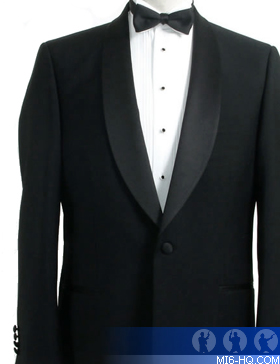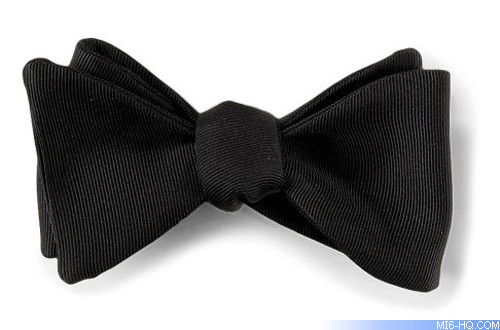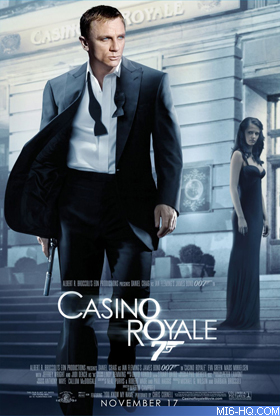 |
| |
With the forthcoming release of "Skyfall" and associated black tie events in mind, guest writer Peter Marshall offers some tips for completing the Bond look...
|
|
Black Tie Guide
10th October 2012
Generally, when men consider donning a tuxedo for the first time, they automatically associate themselves with the legendary super spy. Indeed, this assumption is not without base, and is supported by the popularity of the Google search term "james bond tuxedo" that lead many to my formalwear blog.
Sadly though, the resulting outfits invariably fall short of expectations and are more likely to suggest a licence to serve liquor than a licence to kill. The uninitiated may be tempted to blame their failure on a lack of funds believing that luxury labels are the essential distinction between formal waiters and secret agents. Yet, the truth is that the only requirement for pulling off the Bond look is knowledge of the rules of traditional Black Tie.
The foundation of Black Tie is of course the tuxedo or "dinner jacket" in British spy parlance. Over the past decade contemporary tuxedos have been increasingly styled to resemble business suits as young men have become progressively less familiar with formal suits. To the casual observer the two may appear to be interchangeable, but Bond knows better; as his worldly "Casino Royale" accomplice Vesper Lynd so aptly summarised, "There are dinner jackets and dinner jackets."
The differences arise from the garments' original purposes. The everyday suit was originally known as a "lounge suit" in reference to its role as easy-fitting clothing for leisurely Victorian pursuits in the countryside. Its purpose was simply to be pragmatic. The original tuxedo, on the other hand, was termed a "dinner suit" because it was intended for informal dining and socialising among upper class gentlemen. Although less grand than the era's otherwise obligatory tailcoat, it nonetheless had to be elegant enough to be accepted as evening wear, society's most formal type of attire.
The most obvious indicator of the suits' differing pedigrees is their lapels. Ordinary single-breasted jackets typically have unremarkable notched lapels while tuxedo jackets traditionally feature dégagé shawl collars or stately peak lapels, both faced in lustrous silk. Another significant differentiation is the way the classic tuxedo jacket is cut to feature a single button whereas ordinary suits will have two or three.
This variation allows a deep "V" of white shirt to remain visible when the tuxedo jacket is closed, ensuring maximum exposure of the formal shirt's decorative front, a high level of black and white contrast, and the impression of wide shoulders and a narrow waist. (This is also why traditional evening waistcoats are cut much lower than ordinary suit vests.) Somewhat less obvious is absence of a rear vent that would interfere with the streamlined and therefore sophisticated look of the jacket.
Right: Single-breasted shawl collar. |
|

|
One trait shared by both styles of suits is the essential need for a proper fit. Bond always looks his best by ensuring his jacket is neither draping him like a tent nor constraining him like a sausage casing, his sleeves are just short enough to expose a band of shirt cuff (which extends no further than the bottom of his palm) and his trouser legs are just long enough to cover his socks rather than bunching on top of his shoes. He also knows to use suspenders to keep his trousers perfectly positioned at his waist throughout a long evening of high-stakes gambling and high-speed car chases.
As for the tuxedo's accessories, Bond's American counterpart Felix Leiter would likely tell you that the only true tuxedo shirt is the wing collar but he would be wrong. Prior to the First World War, Black Tie mostly borrowed its accessories from the highly formal White Tie outfit including a starched-front shirt with a detachable upright collar featuring large, stiff wings. Then the tuxedo came into its own in the 1930s when it gained unique accoutrements better suited to its semi-formal stature such as a shirt with a softer bosom and attached turndown collar. This shirt was the Black Tie norm until the invention of a 1970s hybrid that replaced the turndown with a shorter collar decorated with unstarched wings that were flaccid and minuscule. Oddly, American men embraced this novelty despite the fact it made long necks appear thinner and chubby faces appear fatter. The British, however, continued to prefer the formal turndown which may partially explain why Bond always gets the girl, while Felix gets second billing.

Above: Modern butterfly bowtie. When worn with wing collars, bow ties are placed in front of the wings. This positioning is not only proper etiquette but also a practical choice as the collar's wings will help to keep the bow in place by pressing it forward.
|
The formal four-in-hand tie which has become so popular of late may seem to be a similar update to Black Tie formality but in fact it suffers from a number of aesthetic drawbacks compared to the traditional black bow tie. It leads the eye away from the wearer's face instead of underscoring it, it has a longstanding association with funeral attire rather than formal wear, and it cuts in half the dramatic white "V" of the exposed shirt. Also, unlike the way that the relatively ordinary turndown collar is largely concealed by a formal bow, the long tie has no similar accompaniment to hide its pedestrianism. That's why it's best to follow 007's lead and stick with the unimpeachable elegance of the bow tie. Just make sure it's always black and it's always hand-tied; coloured and clip-on neckwear has no place in the wardrobe of an elite secret agent.
As for the vest or cummerbund, Felix would likely view them as redundant relics of the past while Bond would be well aware of their timeless benefits. A distinctive trait of true formal attire is the concealment of working parts such as the trouser waistband and bottom edge of the shirt bosom which are discreetly covered up by either waist covering.

|
|
More relevantly, a tuxedo does not have the benefit of the business suit's long tie to cover the lower portion of shirt that often peaks out beneath the jacket's closed button. This exposed patch of white fabric interferes with the vertical emphasis of the black suit and negates its impression of height and stature. A black cummerbund or waistcoat prevents this shortcoming by discreetly filling the gap.
Ironically, the American trend towards bare-waisted formality received a huge boost in popularity in 2006 when Daniel Craig appeared in an open dinner jacket and uncovered waist on the poster for "Casino Royale". However, bear in mind that this depiction was deliberately constructed to project a rough-edged reinterpretation of the Bond character. Unless you're planning to also duplicate the unbuttoned shirt and undone bow tie shown in the poster, you'd be wise to imitate Craig as he appears in the film instead wherein he hides his shirt bottom by buttoning his jacket and keeping his trousers properly perched at his waist.
|
The final requirement for a proper Black Tie wardrobe is a good pair of formal shoes. If not patent leather they should at least be polished to a mirror-like gloss. And while they don't have to be pumps they must still have a streamlined elegance to them; everyday dress shoes such as brogues or monkstraps simply won't cut it at the Monte Carlo baccarat tables.
So there you have it: the top-secret formula to successfully executing a tuxedo. While it's true that premium fabrics and tailoring would really clinch the Bond look, simply following these no-cost tips will set you above the vast majority of other Black Tie guests these days. Best of all, they apply just as much to rented formal wear as to purchased garments. You really can dress to kill on a budget.
Peter Marshall is the author of the Black Tie Guide, an exhaustive repository of formal attire and a gentleman's guide to evening wear.